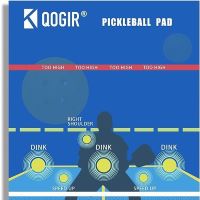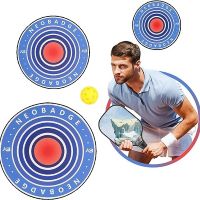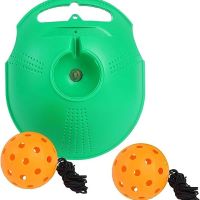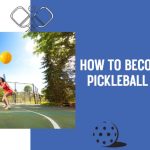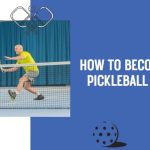Reduce injuries and improve your pickleball game with these must-know pickleball exercises. Pickleball is a great way to stay fit, whether you play for exercise or simply to meet new people. Additionally, it’s an accessible sport (which might explain why it’s the fastest-growing sport in the U.S.).
In isolation, pickleball isn’t dangerous, but improper technique and preparation can lead to injuries. Picklers know that taking time off the court is the last thing they want to do. Here are the best pickleball exercises you can do on and off the court. For each, you have several options, so you can mix and match the ones that work best for you.
You Might Also Like:
5 Best Pickleball Exercises
All pickleball players should perform specific pickleball exercises, regardless of whether it is their main physical activity, part of a wider exercise program, or a fun way to improve their cardiorespiratory fitness. Doing pickleball exercises alone is not enough – you need to mix it up with other types of exercises as well.
The following are the five best exercises every player should do:
1. Warm-Up Exercises
Warming up your body before starting exercises is vital. Pickleball involves a wide range of movements, so it’s best to warm up dynamically. Hips, knees, waist, and shoulders are especially important to warm up.
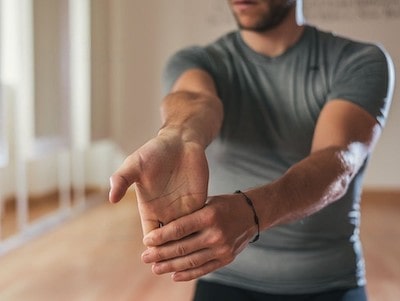
Warm up with these pickleball exercises. For a healthy heart and higher muscle temperature, 10 minutes is enough. You can slow down and reduce the impact if any of these are too challenging.
- Marching – Stand with your feet slightly apart and your arms by your sides. Lift your knees high toward the ceiling as you march in place. Repeat this 20 times.
- Butt Kicks – A 60-second period. Ensure your heels touch your glutes while pumping your arms at the same time.
- High Knees – You should lift your right knee and twist the left side of your body so that your left elbow touches your right knee. Repeat the process on the other side x 4 times.
- Rotating Lunge – With alternate legs, lunge across two pickleball courts. In a prayer position, rotate your body to either side as you reach the ground. Then repeat four more times.
- Leg Swings – Your hips and hamstrings will benefit from this movement. In addition to preparing your lower body for a pickleball workout, leg swings can also serve as a type of cardiovascular exercise.
To know more in detail about pickleball warm up exercises, check this.
2. Strength Exercises
You can prevent ankle sprains, tennis elbow, knee injuries, and lower back aches by increasing your strength. The injury is not caused by pickleball itself but by an unfit body!
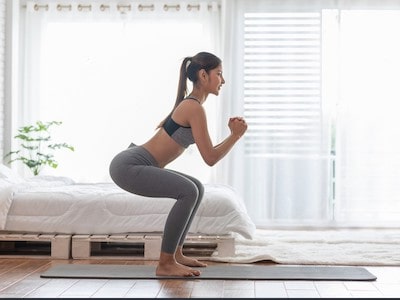
There are specific pickleball strengthening exercises you can do at home if you aren’t already doing strength training. You can build muscular endurance for your lower body if you are already training for upper body strength.
Read more about what to wear to play pickleball for better comfort.
Several times a week, do these easy pickleball exercises until you feel fatigued. Consider incorporating some light weights into any of these that feel particularly easy. Here are the best strengthening exercises for you –
- Bodyweight Squats – You should stand with your hands on the back of your head and your feet shoulder-width apart with your feet turned out slightly to open your hip joint. Bring your thighs parallel to the floor by lowering your body. Take a short pause before returning to your starting position. Then repeat.
- Curtsy Lunges – With both hands hold a dumbbell on your right shoulder. Step your right foot back and around for the curtsy while bringing the weight down to your outside left thigh and extending your arms. Repeat from the beginning.
- Core Twists – Sit on the floor with your legs straight out. By leaning back slightly and bracing your abdominal wall, your body will form a V-shape. Twist your torso from side to side while keeping your legs stationary. Breathe deeply and move slowly. When fatigue sets in, don’t let your core go. Repeat this step.
- Planks and Side Planks – Put your hands under your shoulders (a little wider than shoulder width) like you are about to do a push-up. Squeeze your glutes and ground your toes into the floor to stabilize your body. Be careful not to lock your knees or hyperextend them. Looking about a foot beyond your hands will neutralize your neck and spine. Head and back should be aligned. Hold for 20 seconds.
- Knee Push-Ups – Get down on your knees. Put your hands shoulder-width apart on the floor in front of you. As you bend your arms and lower your torso, tighten your abs. Straighten your arms and push your torso back up. Be patient. Repeat as necessary.
3. Balance Exercises
Balance is essential when playing pickleball. When you chase the ball, you don’t want to land flat on your face! You can reap the benefits of some pickleball exercises off the court and at home during your game by doing these exercises at home.
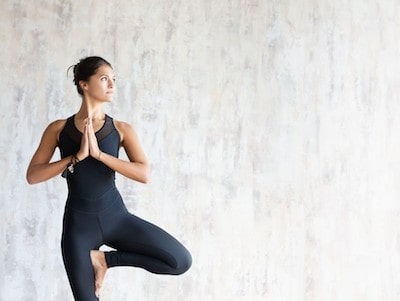
Pickleball can benefit greatly from yoga’s combination of strength, mobility, flexibility, and endurance. Furthermore, it is beneficial to mental health! Consider joining a fitness class or incorporating these exercises into your daily routine.
- Mountain Pose – Balance your feet on both feet while keeping your feet slightly apart. Lift your arms above your head as you inhale. Your palms should be facing up as you interlock your fingers. Focus on what’s ahead. As you exhale, raise your shoulders towards your ears. Straighten your posture and open your chest while rolling back your shoulders and lowering your spine. Don’t tense any muscles. Back up to the starting point.
- Chair Pose – Stand tall, with your feet slightly wider than your hips and your arms at your sides. Stretch your arms parallel with your shoulders, stretching your wrists and fingers long as you inhale. Maintain a neutral spine and keep your shoulders down. Keep your knees and thighs parallel as you bend your knees. Make sure your torso and thighs form a right angle. Be sure to keep your neck, head, and torso in alignment. For 30 seconds to 1 minute, hold.
- Tree Pose – Stand straight with a long, tall back and your feet aligned and touching. Both the left and right sides of your body should be straight. Find a place or object in the room to focus your attention. Slowly shift your weight from your right foot to your left leg. Put your right foot inside your left thigh and align the sole. Your toes should point down, and your pelvis should be straight. Put your palms together and extend your arms straight up to the ceiling.
- High Lunge Pose – Step the right foot forward, knee directly over the ankle, in a Table pose on hands and knees. Straighten the back leg by tucking under the toes. Lift the crown of the head by pressing the palms, fingers, or fists into the floor. Press the chest forward and roll the shoulders back. Keep your chin parallel to the floor and look straight ahead. Press the back of the knee up toward the ceiling while extending the back leg. Sink your hips into the ground and relax. Breathe in and out for 2-6 breaths. Lower the left knee and slide the right knee back into the Table, or step back into Downward Facing Dog. Then repeat
- Dancer pose – Start by shifting your weight to your left foot at the front of the mat. Bring your right heel toward your buttock while bending your right knee. Grab your foot’s arch or outer edge with your right hand. Reach your left arm forward while slowly pressing your foot toward the wall behind you. Reposition your right knee to line up with your hip if it is out to the side. Take a slight backbend by folding forward at your hips and lifting your chest. Look straight ahead at a fixed point.
4. Mobility & Agility Exercises
With mobility training, you can jump higher, run faster, have a greater range of motion, and move pain-free. You can improve your power, speed, reaction time, and hand-eye coordination with agility exercises!
As a result, you will be able to play pickleball even more! Working on multijoint movements with your body weight is the most important thing. Such movements will benefit you not only in pickleball but in everyday life as well.
Here are some exercises to improve mobility and agility for pickleball –
- Fast Feet – To perform a mid-squat, stand with your feet wider than your hip distance and bend at your knees and hinge at your hips. Keeping your toes, run in place. Alternate feet as quickly as you can for 15 to 20 seconds.
- Skaters – Keeping your feet hip distance, step your right leg back, then bend your knees and hinge your hips into a small lunge. You should look down, then jump out to the right with your left foot, landing on your right foot with your left leg bent behind you. Jump left with your right foot, landing on your left foot while your right leg is bent behind you. Alternate directions for 15 to 20 seconds.
- Grapevine – Stand with your feet hip-distance apart, elbows bent, and arms at chest height. After stepping the left foot behind the right foot, quickly step the right foot out to the right. Right foot out to the right and left foot in front, forming a quick crisscross motion. Move crisscross-style to the right, then switch directions to the left by stepping right foot forward and behind. Repeat, alternate directions for 45-60 seconds.
- Glute Bridges – Your knees should be bent, your feet flat on the floor, and your arms by your side as you lie on your back. You should lift and lower your butt.
- Cat Cow pose – You should be standing with your hands shoulder-width apart, rounding your back and lowering your head. Hold this position for five seconds. Next, arch your back and lift your bum. You can do this five times to gently mobilize your spine
Check out our blog post on pickleball tips doubles to learn more about pickleball.
5. Stretching Exercises
Pickleball players often skip stretching and cooling down after games. In terms of recuperation time, it does make a difference. During a game, certain areas of the body receive the most attention.
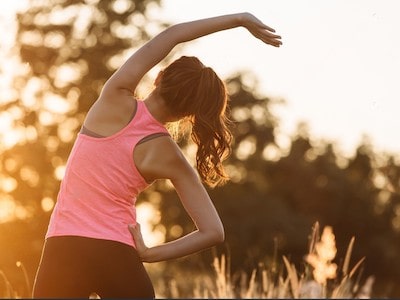
The routine below focuses on these areas. You should hold each movement for 30-40 seconds if you are over 60 years. Hold for 60-90 seconds if you are under 60.
- Hamstring Stretch – Stand tall, and bend forward at the hips. Make sure you don’t push it too far – just until your hamstrings feel stretched.
- Quadriceps Stretch – You should lift your heel toward your buttocks while balancing on one leg. Then switch to the other leg.
- Standing Knee Hugs – Take one knee and hug it close to your chest while standing tall. After that, switch sides. Holding on to a post, wall, or tree can help you keep your balance.
- Lunge Twist Stretch – Stretch deeply by lunging forward with one leg and twisting your body at the hips over the front leg while keeping your torso upright. Avoid twisting your hips. After stretching one side, switch to the other.
- Supine Spinal Twist – Stretch your legs out straight on your back while lying on your back. Place one knee across your body and lift it toward your chest. Look toward your extended arm as you stretch the opposing arm away from your body.
FAQs
Three key things pickleball players must focus areDrill, Practice, and Playing. Most pickleball players only play. You must practice and drill if you want to improve. If you want to improve, you need to practice and drill.
Pickleball requires rapid movements in all directions that require short bursts of physical exertion. In pickleball, agility, coordination, balance, and endurance are the four most important physical fitness areas.
As mentioned previously, pickleball provides a good aerobic workout without putting too much stress on your joints and muscles. Exercise releases endorphins and other bioamines that help to boost self-esteem and fight depression – two problems associated with ageing.
Wrapping Up
Consult a fitness professional before trying any of the pickleball exercises, or pickleball stretches mentioned. You can benefit from pickleball with minimal risk by creating an exercise regimen based on its demands. If you feel tired or something hurts, stop!
It may feel uncomfortable or stretch you a bit, but these pickleball exercises shouldn’t hurt. As a final note, pickleball is not only fun but also an essential part of a healthy lifestyle. If you’ve got a long rally ahead, ensure to hydrate and eat well, including carbohydrates.

I am a professional physiotherapist and the author of the BallSportsPro. I worked with athletes of all levels, from amateur to professional, and i helped them overcome injuries and improve their performance. I am a certified Pickleball instructor and has been playing the sport for over 10 years.

